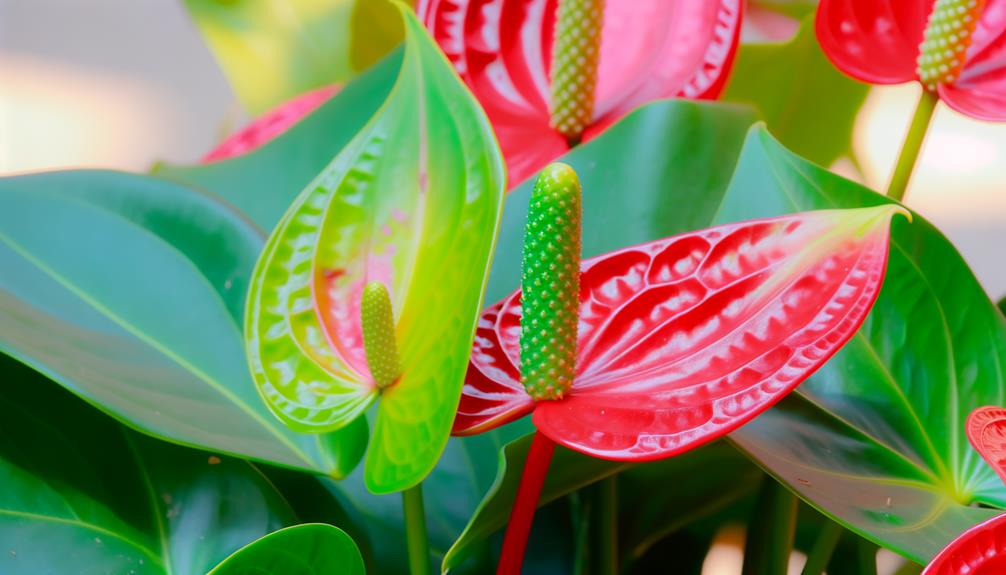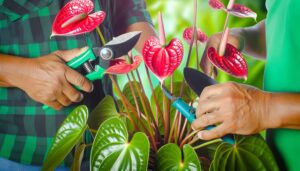Why Is My Anthurium Flower Turning Green?
Your anthurium flower might turn green due to several factors. Natural aging increases chlorophyll production as pigments break down.
Low light causes etiolation, turning flowers green. Overwatering leads to oxygen deprivation and root decay, which impacts nutrient uptake.
Nutrient imbalances, especially in phosphorus or potassium, cause green hues. Temperature stress can disrupt pigment production and change flower color.
Ensuring proper light exposure, correct watering practices, balanced fertilization, and stable temperatures can help maintain your anthurium's vibrant color. Keep exploring to discover more insights into maintaining the health of your anthurium.

Key Takeaways
- Insufficient light exposure can cause anthurium flowers to develop a greenish hue due to increased chlorophyll production.
- Overwatering leads to oxygen deprivation in the roots, causing nutrient absorption issues and potentially turning the flowers green.
- Nutrient imbalances, particularly deficiencies in phosphorus or potassium, can result in the green coloration of anthurium flowers.
- Temperature stress from fluctuations disrupts metabolic processes, affecting pigment production and causing flowers to turn green.
- The natural aging process of the flower can increase chlorophyll production, leading to a greenish hue as the flower senesces.
Natural Aging Process
As anthurium flowers age, their vibrant colors often fade and turn green due to chlorophyll production increasing as a protective mechanism. This process, known as senescence, involves the breakdown of pigments like anthocyanins and carotenoids.
As these pigments degrade, chlorophyll, the green pigment, becomes more prevalent. You'll notice this shift particularly as the flower progresses from its peak blooming phase to the later stages of its lifecycle.
Research indicates that this chlorophyll increase helps the plant maximize photosynthesis, even as it ages. It's a natural adaptation that ensures the plant can continue to generate energy efficiently.
Monitoring this process can offer insights into the plant's health and lifecycle, allowing you to better care for your anthurium.
Insufficient Light Exposure
Insufficient light exposure can trigger an increase in chlorophyll production in anthurium flowers, causing them to turn green. When light levels are low, the plant compensates by producing more chlorophyll to maximize photosynthesis. This process is known as etiolation and can lead to a greenish hue in your anthurium flowers.
To maintain their vibrant colors, optimize your anthurium receives adequate light. Here are a few steps to improve light conditions:
- Position near a window: Place your plant near an east or west-facing window for best indirect sunlight.
- Supplement with artificial light: Use grow lights if natural light is insufficient.
- Rotate the plant: Ensure even light distribution by rotating the plant periodically.
- Clean the leaves: Dust can block light absorption, so keep leaves clean.
Overwatering Issues
Overwatering can lead to oxygen deprivation in the root zone, causing anthurium flowers to turn green due to impaired nutrient absorption and root decay.
When roots are waterlogged, they can't access the oxygen needed for respiration, resulting in hypoxia. This condition hampers the plant's ability to absorb essential nutrients, leading to chlorosis or green-tinged flowers.
Additionally, excessive moisture promotes pathogens like Pythium and Phytophthora, which cause root decay. Root decay further restricts nutrient flow, exacerbating the greening of your anthurium flowers.
To address overwatering issues, ensure proper drainage, use a well-aerated potting mix, and let the soil dry out between waterings. Monitoring moisture levels with a soil moisture meter can also help prevent overwatering.
Nutrient Imbalances
When addressing anthurium flowers turning green, it's important to contemplate nutrient imbalances as a potential cause, particularly deficiencies in phosphorus or potassium. These essential nutrients play a critical role in flower pigmentation and overall plant health.
Guaranteeing your anthurium receives balanced fertilization can mitigate this issue. To diagnose and correct nutrient imbalances, you should:
- Test Soil Nutrients: Use a soil test kit to identify deficiencies, focusing on phosphorus and potassium levels.
- Adjust Fertilizer: Opt for a balanced, slow-release fertilizer with equal N-P-K ratios or specific bloom-boosting formulations.
- Monitor pH Levels: Assure soil pH is between 5.5 and 6.5, as improper pH can hinder nutrient absorption.
- Inspect Water Quality: High mineral content in water can cause imbalances, so consider using distilled or rainwater.
Understanding these factors will help maintain your anthurium's vibrant flowers.
Temperature Stress
Temperature fluctuations can greatly stress anthurium plants, leading to a change in flower pigmentation, often causing them to turn green. Anthuriums thrive in stable, warm conditions, ideally between 70-85°F.
When temperatures drop below this range or spike suddenly, the plant's metabolic processes become disrupted. This disruption affects the production of anthocyanins, pigments responsible for the flower's red hue, causing them to diminish. Consequently, the chlorophyll, which is green, becomes more prominent.
To mitigate temperature stress, make sure your anthurium is placed away from drafts, air conditioning, and direct heat sources. Monitoring the ambient temperature with a reliable thermometer can help maintain the ideal conditions for your plant. Consistent temperature regulation is key to preserving the vibrant color of your anthurium flowers.
Pests and Diseases
You might notice the Anthurium's flowers turning green due to common pests like aphids, spider mites, and mealybugs, which feed on the plant's sap, weakening it. These pests can introduce pathogens that cause diseases such as bacterial blight or root rot, greatly affecting the plant's health.
Identifying symptoms like discolored leaves, wilting, and mold growth early can help you take prompt action to mitigate damage.
Common Anthurium Pests
Why do anthuriums often fall prey to pests like aphids, spider mites, and mealybugs, which can cause significant damage and discoloration to the leaves and flowers? These pests are drawn to the high humidity and warm conditions that anthuriums require. They feed on plant sap, weakening the plant and promoting fungal growth.
Here are the primary pests to monitor:
- Aphids: These small insects cluster on new growth, excreting honeydew that can lead to sooty mold.
- Spider Mites: These tiny arachnids create webbing and stippling on leaves, causing them to lose color.
- Mealybugs: These pests appear as white cottony masses, sucking sap and excreting honeydew.
- Scale Insects: They attach to stems and leaves, forming hard, shell-like coverings, and excrete honeydew, attracting ants.
Disease Symptoms Overview
Many anthurium disease symptoms manifest through chlorosis, wilting, and necrotic lesions. Chlorosis is usually a sign of nutrient deficiencies or root rot caused by overwatering. Wilting can result from soil-borne pathogens like Pythium or Phytophthora. Necrotic lesions, or dead tissue spots, often arise from bacterial blight (Xanthomonas) or fungal infections like Anthracnose.
Pests such as aphids or spider mites can exacerbate these symptoms by weakening the plant's defenses. Regularly inspect your anthurium for these signs and consider soil testing and proper watering techniques.
Early detection and targeted treatment are key to keeping your anthurium healthy and vibrant.
Seasonal Changes
As the seasons shift, changes in light intensity and temperature can greatly influence the coloration of anthurium flowers. Reduced sunlight and cooler temperatures during fall and winter can lead to less vibrant pigmentation, often turning your flowers green.
You can manage these seasonal changes by adjusting your plant care routine:
- Light: Move your anthurium to a brighter spot to compensate for reduced daylight.
- Temperature: Keep indoor temperatures stable, ideally between 70-85°F (21-29°C).
- Humidity: Maintain high humidity levels, around 70-80%, using a humidifier if necessary.
- Watering: Reduce watering frequency to prevent root rot, as cooler temperatures slow down evaporation.
Conclusion
So, there you have it! Your anthurium flower turning green can be due to natural aging, insufficient light, overwatering, nutrient imbalances, temperature stress, pests, or seasonal changes.
By understanding these factors and adjusting your plant care routine, you can guarantee your anthurium thrives.
So, hop in your DeLorean, travel back to the fundamentals of plant care, and give your anthurium the attention it needs to flourish.
Happy gardening!






